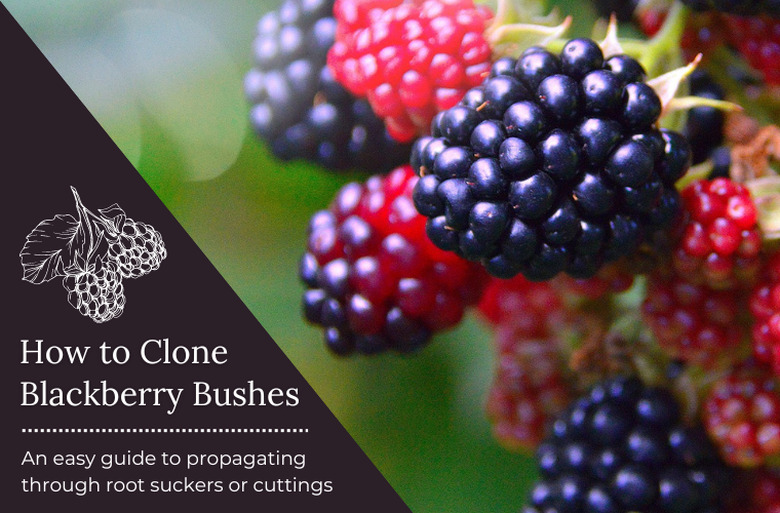How To Clone Blackberry Bushes
Cloning or propagating blackberries at home is a simple project for beginner and experienced gardeners alike. According to the University of Florida, blackberries (Rubus fruticosus) grow best within U.S. Department of Agriculture plant hardiness zones 4 to 10, including thornless varieties, such as the Arapaho blackberry (Rubus fruticosus 'Arapaho'), and thorny, erect varieties, such as Brazos (Rubus fruticosus 'Brazos').
All blackberry cultivars, or cultivated varieties, must be cloned rather than started from seed to preserve their good qualities. The quickest and simplest method for propagating blackberry bushes is to transplant a root sucker, but other clonal methods, such as stem cuttings and root cuttings, also work well.
Things Needed
- Small garden trowel
- Sharp pruning shears
- Nursery pot
- Potting soil
- Gardening gloves
- Goggles
Propagating Blackberries From Root Suckers
Root suckers provide the fastest and easiest way of cloning blackberry plants at home. According to the Texas A&M University Department of Horticulture, this propagation method should be done in spring after new leafy growth appears on the canes but before flower buds form.
The process is simple to do and requires very little equipment, including a small garden trowel, sharp pruning shears, a nursery pot with holes and fresh potting soil. It is also a good idea to wear gardening gloves and goggles to protect yourself if you are cloning a thorny blackberry variety.
Locate a blackberry sucker near the base of a healthy bramble. Dig down midway between the sucker and the main plant until you uncover the thick root that connects the two. Snip the root with pruning shears and transplant the sucker into a pot filled with moist potting soil. Bury the rooted portion of the sucker and snip off half of the leaves from the top portion.
Blackberry suckers should be grown under bright, sheltered nursery conditions for one year before transplanting them into a permanent site.
Things Needed
- 1-gallon nursery pot
- Coir and sand or perlite
- Pruning shears or scissors
- Rooting hormone
Cloning Blackberries From Cuttings
Blackberry brambles also grow well from leafy stem cuttings, which is the best method to use when starting large quantities of brambles at once. Early spring is the best time to start blackberry cuttings because they will root best when the growth is fresh and green.
Prepare a pot before gathering the blackberry cuttings so they can be potted up immediately after they are cut. A 1-gallon nursery pot filled with a moistened mixture of half coir and half sand or perlite can hold up to five blackberry cuttings, which can later be transplanted into individual pots or directly into the garden.
The University of Florida IFAS Extension recommends gathering cuttings that are 4 to 6 inches long. Make the cut just below a pair of leaves using sharp pruning shears or scissors. Strip off the leaves from the bottom half of the cutting and dust the stem with rooting hormone. Pot the cutting at a 2-inch depth with the lowest set of leaves just above the soil surface.
Blackberry cuttings will root in two to four weeks if kept under humid conditions with bright, indirect sunlight.
Things Needed
- Sharp knife or pruning shears
- Nursery pot
- Potting soil
- Plastic bag
Propagating Blackberry Root Cuttings
Root cuttings taken from blackberry brambles grow rapidly and will produce a plant very quickly, although it will still take a year or two for the new plant to produce fruit. An ideal root cutting is 6 inches long and 1/4 to 1/2 inch in diameter with a smooth, healthy appearance and no signs of damage or disease.
Dig the root cuttings from the base of the bramble, cutting the root with a sharp knife or pruning shears. The cuttings can be planted immediately in the garden or into nursery pots filled with potting soil. It is also possible to store blackberry root cuttings in a plastic bag inside the refrigerator for planting in winter.
Blackberry root cuttings should be covered with 2 to 4 inches of soil. The Purdue University Extension Service recommends planting thin root cuttings horizontally, while thicker root cuttings can be positioned horizontally or vertically.
Potted cuttings should be grown in large nursery pots filled with potting soil for no longer than one year before they are transplanted into a permanent bed. In the garden, plant the root cuttings at a depth of 2 to 4 inches in a sunny bed with fertile, fast-draining soil.
